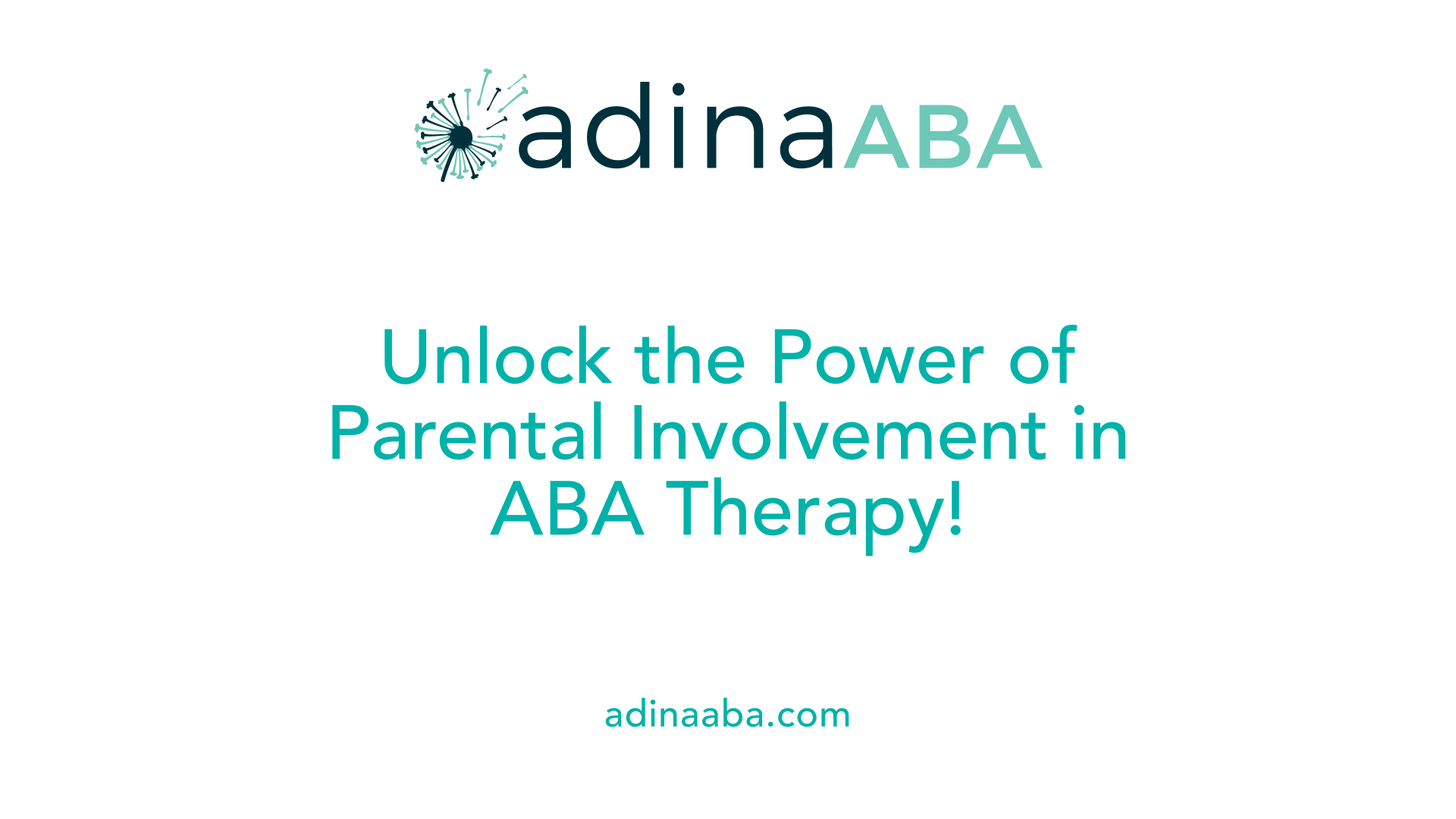The Importance of Encouragement in ABA Therapy Success

Exploring the Power of Encouragement in ABA Therapy
Applied Behavior Analysis (ABA) therapy is a well-established approach for helping children with autism develop essential life skills. Central to its success is the use of encouragement, which plays a crucial role in reinforcing positive behaviors and fostering growth. This article delves into the importance of encouragement in ABA therapy, exploring its profound impact on therapy outcomes, strategies for enhancing success, and the emotional advantages it offers. By understanding these elements, parents, therapists, and caregivers can better support children in achieving their developmental goals.
The Role of Positive Reinforcement in ABA Therapy

Importance of Positive Reinforcement in ABA
Positive reinforcement is a cornerstone of Applied Behavior Analysis (ABA) therapy, pivotal for encouraging desirable behaviors in children. By rewarding specific actions with enjoyable outcomes, positive reinforcement motivates children to repeat those behaviors in the future. This technique not only supports skill development but also promotes a child's self-esteem and encourages consistent learning.
The principles of positive reinforcement were laid out by B.F. Skinner, who emphasized that the consequences of a behavior influence its future occurrence. In practical terms, this means that when a child receives timely praise or rewards for positive actions, they are more likely to engage in these behaviors repeatedly.
Effectiveness of ABA Therapy in Skill Development
ABA therapy utilizes positive reinforcement to help children develop essential skills, including communication, social interaction, and self-regulation. By breaking down tasks into manageable steps and using reinforcement to celebrate achievements, children become more confident in their abilities.
The effectiveness of this approach is further enhanced when therapists adhere to the ABC model of behavior analysis:
| Component | Explanation | Example |
|---|---|---|
| Antecedent | The event or environment that triggers a behavior | A student is asked a question in class |
| Behavior | The observable action that occurs | The student raises their hand to answer |
| Consequence | The result that follows the behavior | The student receives praise for correct response |
When a child successfully participates in an activity and is rewarded, their engagement is reinforced, leading to greater progress in therapy. In this way, positive reinforcement is not just a strategy for improving behavior but a fundamental tool that shapes learning and development in children receiving ABA therapy.
Motivating Operations and Their Impact on Therapy
What is a motivating operation in ABA?
A motivating operation (MO) in Applied Behavior Analysis (ABA) plays a critical role in shaping behavior. It refers to any environmental variable that alters the effectiveness of a stimulus as a reinforcer or punisher. Essentially, the context or conditions can enhance or diminish the reinforcing value of a stimulus.
For example, consider when a child is deprived of food. In this state, the desire for food becomes much stronger, thus increasing the likelihood of behaviors that might lead to access to food. This shift underscores how motivation can be influenced by circumstances such as hunger or social deprivation.
In practice, MOs help practitioners determine how to tailor interventions effectively by considering what factors are influencing a child’s behavior at any given time. Thus, they are essential for ensuring that reinforcement strategies are optimally effective for each individual's needs, fostering a more responsive learning environment.
Influence of environmental variables
Environmental variables can significantly impact children’s behaviors within ABA therapy. Consider the following elements:
- Contextual Changes: Changes in the environment, such as different settings or the presence of peers, can alter the effectiveness of motivational strategies.
- Routine Variability: A predictable daily routine may enhance a child's sense of security and motivation, while abrupt changes may lead to decreased engagement.
- Emotional States: Children may act differently based on their emotional state, impacting how they respond to reinforcement or consequences.
Understanding these variables is vital for creating individualized therapy plans that meet children's unique needs. By recognizing how motivating operations shift, therapists can enhance the success of ABA therapy, ensuring children stay engaged and motivated in their learning process.
Customized Strategies for Success in ABA Therapy
Significance of Individualized Therapy Plans
The effectiveness of ABA therapy largely hinges on the use of individualized therapy plans. These plans are meticulously crafted to address the unique needs and goals of each child, allowing for tailored intervention strategies. By focusing on specific behaviors, therapists can better engage children and encourage them to develop essential skills such as communication and self-regulation.
Moreover, these personalized approaches contribute to the success of ABA therapy by creating a structured environment where progress can be meticulously tracked. Targeted goals ensure that children receive appropriate support, enhancing their likelihood of achieving developmental milestones.
Integration of Children's Interests
Another critical factor in the success of ABA therapy is the integration of children's interests into lesson plans. This adaptive method leverages what captivates a child to maintain their attention and motivation during therapy sessions. Involving interests not only enhances engagement but also promotes long-term learning outcomes.
For instance, when a child's favorite toys or activities are woven into the learning process, it makes the experience enjoyable. This approach aligns with Pivotal Response Treatment (PRT), which emphasizes motivation and aims to foster communication and social interactions by tapping into what children love.
Elements Contributing to ABA Therapy Success
The overall success of ABA therapy stems from several key elements:
| Factors | Description |
|---|---|
| Individualized Goals | Customized plans that reflect each child's specific needs and targets. |
| Positive Reinforcement | Techniques that reward desired behaviors to reinforce learning and habits. |
| Engaging Interests | Utilizing children's preferences to keep them motivated and focused during sessions. |
| Measurable Outcomes | Data-driven tracking of progress to inform and adjust therapeutic strategies effectively. |
| Family Involvement | Encouraging parental involvement to create a consistent support system at home. |
By combining these elements, ABA therapy effectively empowers children with autism, enhancing communication, social skills, and independence.
Early Intervention and Encouragement in ABA

Benefits of Early Intervention
Starting ABA therapy early can significantly impact a child's development. Young brains are highly adaptable and receptive to learning, making this an ideal time to address challenges associated with autism. Research shows that early intervention leads to better outcomes in terms of communication, social skills, and overall behavior.
Children who begin ABA therapy at a young age often achieve milestones more timely, as the therapy equips them with essential life skills. These include self-regulation, communication, and independence, all of which are crucial for flourishing in various life situations.
Importance of Positive Support in Formative Years
Positive support during these formative years is vital for children's long-term success. ABA therapy emphasizes reinforcement and motivation, using enjoyable outcomes to encourage desired behaviors. This approach not only fosters learning but also builds a child's self-esteem, creating a nurturing environment for growth.
When parents and caregivers are actively involved, the consistency offered reinforces the skills learned during therapy. Such an environment nurtures emotional well-being and reduces family stress, which results in a harmonious home life. By combining early intervention with tailored support, children are more likely to thrive, forming a solid foundation for future development.
The Emotional Advantages of Encouragement in Therapy

Enhancing Emotional Well-Being
Encouragement plays a significant role in enhancing the emotional well-being of children undergoing ABA therapy. Children learn best in an environment where positive feedback is consistently provided. This positive reinforcement not only motivates children to acquire new skills but also improves their self-esteem and confidence. As they experience success in achieving milestones, their emotional development flourishes, fostering a sense of accomplishment.
By breaking down tasks into manageable components, ABA therapists make complex skills easier to grasp, providing a gradual sense of success. This systematic approach reassures children that they are making progress, contributing further to their emotional resilience and stability.
Reducing Family Stress
ABA therapy's structured nature significantly alleviates family stress. By addressing challenging behaviors effectively, the therapy fosters a peaceful home environment. Families learn strategies to manage difficult situations, leading to improved emotional dynamics within the household.
Additionally, parental involvement is crucial, as it ensures the reinforcement of learned behaviors at home. When parents actively participate in reinforcing skills, it creates a unified approach toward therapy goals, further enhancing both the child's development and the family’s well-being. This alignment between home and therapy provider reduces frustration, creating a nurturing space for the child to thrive emotionally.
Parental Involvement and Supportive Environments

Impact of Parental Involvement
Parental involvement is a cornerstone of effective ABA therapy. Engaged parents can significantly enhance their children's progress by reinforcing skills learned during therapy sessions at home. This consistency aids in solidifying new behaviors and ensures that the child experiences constant encouragement in their learning journey. By actively participating in the therapy process, parents can gain insights into their child’s unique needs, allowing them to create tailored strategies that extend beyond the therapy environment.
Creating Supportive Environments
A supportive home environment fosters growth and development in children undergoing ABA therapy. Parents can create such environments by establishing routines, utilizing positive reinforcement, and addressing challenging behaviors proactively. This structured approach not only benefits the child’s learning but also reduces family stress, promoting emotional well-being within the household. The harmonious atmosphere will help the child feel secure and motivated, leading to improved outcomes in their therapy. By championing their child’s needs and aspirations, parents become instrumental in their success.
| Benefits of Parental Involvement | Strategies for a Supportive Environment | Impact on Child's Growth |
|---|---|---|
| Reinforces skills from therapy | Establish consistent routines | Improved learning retention |
| Enhances understanding of needs | Use positive reinforcement | Boosts motivation and confidence |
| Reduces child's anxiety | Address challenging behaviors proactively | Fosters a sense of security |
The Ripple Effect: Encouragement Beyond the Therapy Room

Fostering independence and self-esteem
ABA therapy plays a pivotal role in helping children with autism develop crucial life skills that encourage independence. By breaking tasks into smaller, manageable steps, therapists guide children through activities like dressing themselves, preparing a snack, or using the bathroom. This structured approach promotes self-reliance and gradually builds the child's confidence.
As children begin to master these skills, their self-esteem grows alongside their newfound independence. Celebrating small successes during therapy reinforces positive behavior, encouraging children to take on challenges that may have previously felt daunting.
Improving overall quality of life
The benefits of ABA therapy extend beyond skill acquisition to positively impact the child’s overall quality of life. The therapy not only helps in reducing problem behaviors but also fosters better social interactions. As children learn to communicate effectively and engage socially, they create meaningful relationships with peers and family members.
This enhanced communication leads to more probing conversations, shared experiences, and the ability to express their feelings, contributing to a more harmonious environment at home and in school. Ultimately, these interactions help create a stable emotional environment, releasing stress not just from the child, but the entire family.
By implementing strategies learned in therapy both at home and in community settings, families benefit from a supportive atmosphere where progress is consistent, significantly improving their overall well-being.
Concluding Thoughts on Encouragement in ABA Therapy
Encouragement is a vital element in the success of ABA therapy. By utilizing positive reinforcement and understanding motivating operations, therapists can effectively support children with autism in developing crucial life skills. The inclusion of parents and personalized therapy plans further enhances the outcomes, leading to improved family dynamics and a better quality of life for everyone involved. Emphasizing encouragement not only aids in reaching immediate therapy goals but also lays the foundation for long-term, sustainable success. As the ABA community continues to evolve, the power of encouragement remains a cornerstone, driving positive change and fostering prosperity in the lives of those it touches.
References
- Benefits of ABA Therapy for Children with Autism
- Motivational Learning Through ABA Therapy | Blossom
- 7 Surprising Benefits of ABA Therapy for Kids You Need to Know
- ABA 101: Positive Reinforcement - Behavior TLC
- ABA Therapy for Autism: Benefits and Examples - Verywell Health
- Motivating Operation - Study Notes ABA
More Resources
Expert Clinicians
Get started today ->



.jpg)


